Electrochemical Corrosion of Galvanized Steel in Binary Sustainable Concrete Made with Sugar Cane Bagasse Ash (SCBA) and Silica Fume (SF) Exposed to Sulfates
Abstract
1. Introduction
2. Materials and Methods
2.1. Materials Used for Made Binary Sustainable Concrete
2.2. Dosage of Binary Sustainable Concretes
2.3. Test to the Fresh and Hardened Conventional Concrete and Binary Sustainable Concretes
2.4. Nomenclature of the Studied Specimens CC, BSC1 and BSC2
2.5. Characteristic of Test Specimens and Electrochemical Cell for the Monitoring of Corrosion
3. Results and Discussion
3.1. Corrosion Potential (Ecorr)
3.1.1. Ecorr Galvanized Steel and AISI 1018 Carbon Steel in Concrete Exposed to Control Medium (DI-Water)
3.1.2. Ecorr Galvanized Steel and AISI 1018 Carbon Steel in Concrete Exposed to 3.5 wt.% MgSO4 Solution
3.2. Corrosion Current Density (icorr)
3.2.1. Behavior icorr Galvanized Steel and AISI 1018 Carbon Steel in Concrete Exposed to Control Medium
3.2.2. icorr Galvanized Steel and AISI 1018 Carbon Steel in Concrete Exposed to 3.5 wt.% MgSO4 Solution
4. Conclusions
Author Contributions
Funding
Institutional Review Board Statement
Informed Consent Statement
Acknowledgments
Conflicts of Interest
References
- Worrell, E.; Price, L.; Martin, N.; Hendriks, C.; Ozawa, L.M. Carbon dioxide emissions from the global cement industry. Annu. Rev. Energy Environ. 2001, 26, 303–329. [Google Scholar] [CrossRef]
- Monteiro, P.; Miller, S.; Horvath, A. Towards sustainable concrete. Nat. Mater. 2017, 16, 698–699. [Google Scholar] [CrossRef]
- Mahasenan, N.; Smith, S.; Humphreys, K. The cement industry and global climate change current and potential future cement Industry CO2 emissions. In Proceedings of the Greenhouse Gas Control Technologies—6th International Conference, Kyoto, Japan, 1–4 October 2002; Elsevier: Amsterdam, The Netherlands, 2003; pp. 995–1000. [Google Scholar]
- Landa, A.; Croche, R.; Márquez-Montero, S.; Galván-Martínez, R.; Tiburcio, C.G.; Almeraya Calderón, F.; Baltazar, M. Correlation of compression resistance and rupture module of a concrete of ratio w/c= 0.50 with the corrosion potential, electrical resistivity and ultrasonic pulse speed. ECS Trans. 2018, 84, 217–227. [Google Scholar] [CrossRef]
- Harilal, M.; Rathish, V.R.; Anandkumar, B.; George, R.P.; Haji, M.S.; Philip, J.; Amarendra, G. High performance green concrete (HPGC) with improved strength and chloride ion penetration resistance by synergistic action of fly ash, nanoparticles and corrosion inhibitor. Constr. Build. Mater. 2019, 198, 299–312. [Google Scholar] [CrossRef]
- Landa, L.; Ariza, H.; Santiago, G.; Moreno, V.; López, R.; Villegas, R.; Márquez, S.; Croche, R.; Baltazar, M. Evaluation of the behavior of the physical and mechanical properties of green concrete exposed to magnesium sulfate. Eur. J. Eng. Res. Sci. 2020, 5, 1353–1356. [Google Scholar] [CrossRef]
- Cramer, S.D.; Covino, B.S., Jr.; Bullard, S.J.; Holcomb, G.R.; Russell, J.H.; Nelson, F.J.; Laylor, H.M.; Soltesz, S.M. Corrosion prevention and remediation strategies for reinforced concrete coastal bridge. Cem. Concr. Compos. 2002, 24, 101–117. [Google Scholar] [CrossRef]
- Santiago, G.; Maldonado-Bandala, E.E.; Olguin Coca, F.J.; Almeraya-Calderón, F.; Torres-Acosta, A.; Baltazar-Zamora, M.A. Electrochemical behavior of reinforced concrete and its relation with the environment of Xalapa, Veracruz. Int. J. Electrochem. Sci. 2012, 7, 9825–9834. [Google Scholar]
- Raczkiewicz, W.; Wójcicki, A. Temperature impact on the assessment of reinforcement corrosion risk in concrete by galvanostatic pulse method. Appl. Sci. 2020, 10, 1089. [Google Scholar] [CrossRef]
- Volpi-León, V.; López-Léon, L.D.; Hernández-Ávila, J.; Baltazar-Zamora, M.A.; Olguín-Coca, F.J.; López-León, A.L. Corrosion study in reinforced concrete made with mine waste as mineral additive. Int. J. Electrochem. Sci. 2017, 12, 22–31. [Google Scholar] [CrossRef]
- Chalhoub, C.; François, R.; Carcasses, M. Critical chloride threshold values as a function of cement type and steel surface condition. Cem. Concr. Res. 2020, 134, 106086. [Google Scholar] [CrossRef]
- Sudheer, S.; Raghu Babu, U.; Kondraivendhan, B. Influence of metakaolin and red mud blended cement on reinforcement corrosion in presence of chloride and sulfate ions. Sustain. Constr. Build. Mater. 2019, 25, 717–725. [Google Scholar]
- Troconis de Rincón, O.; Montenegro, J.C.; Vera, R.; Carvajal, A.M.; De Gutiérrez, R.M.; Del Vasto, S.; Saborio, E.; Torres-Acosta, A.; Pérez-Quiroz, J.; Martínez-Madrid, M.; et al. Reinforced Concrete Durability in Marine Environments DURACON Project: Long-Term Exposure. Corrosion 2016, 72, 824–833. [Google Scholar] [CrossRef]
- Liang, M.T.; Lan, J.-J. Reliability analysis for the existing reinforced concrete pile corrosion of bridge substructure. Cem. Concr. Res. 2005, 35, 540–550. [Google Scholar] [CrossRef]
- Baltazar, M.A.; Márquez, S.; Landa, L.; Croche, R.; López, O. Effect of the type of curing on the corrosion behavior of concrete exposed to urban and marine environment. Eur. J. Eng. Technol. Res. 2020, 5, 91–95. [Google Scholar] [CrossRef]
- Santiago-Hurtado, G.; Baltazar-Zamora, M.A.; Olguín-Coca, J.; López, L.D.; Galván-Martínez, R.; Ríos-Juárez, A.; Gaona-Tiburcio, C.; Almeraya-Calderón, F. Electrochemical evaluation of a stainless steel as reinforcement in sustainable concrete exposed to chlorides. Int. J. Electrochem. Sci. 2016, 11, 2994–3006. [Google Scholar] [CrossRef]
- Bastidas, D.M.; Cobo, A.; Otero, E.; González, J.A. Electrochemical rehabilitation methods for reinforced concrete structures: Advantages and pitfalls. Corros. Eng Sci. Technol. 2008, 43, 248–255. [Google Scholar] [CrossRef]
- Bastidas, D.M.; González, J.A.; Feliu, S.; Cobo, A.; Miranda, J.M. A quantitative study of concrete-embedded steel corrosion using potentiostatic pulses. Corrosion 2007, 63, 1094–1100. [Google Scholar] [CrossRef]
- Cosoli, G.; Mobili, A.; Giulietti, N.; Chiariotti, P.; Pandarese, G.; Tittarelli, F.; Bellezze, T.; Mikanovic, N.; Revel, G.M. Performance of concretes manufactured with newly developed low-clinker cements exposed to water and chlorides: Characterization by means of electrical impedance measurements. Constr. Build. Mater. 2020, 271, 121546. [Google Scholar] [CrossRef]
- Pham, V.T.; Meng, P.; Trinh Bui, P.; Ogawa, Y.; Kawai, K. Effects of Shirasu natural pozzolan and limestone powder on the strength and aggressive chemical resistance of concrete. Constr. Build. Mater. 2020, 239, 117679. [Google Scholar] [CrossRef]
- Dalla, P.T.; Tragazikis, I.K.; Exarchos, D.A.; Konstantinos, G.; Dassios, K.G.; Barkoula, N.M.; Matikas, T.E. Effect of carbon nanotubes on chloride penetration in cement mortars. Appl. Sci. 2019, 9, 1032. [Google Scholar] [CrossRef]
- Gyeongcheol, C.G.; Shinohara, Y.; Kim, G.; Lee, S.; Lee, E.; Nam, J. Concrete corrosion cracking and transverse bar strain behavior in a reinforced concrete column under simulated marine conditions. Appl. Sci. 2020, 10, 1794. [Google Scholar]
- Santiago-Hurtado, G.; Baltazar-Zamora, M.A.; Galindo, D.A.; Cabral, M.J.A.; Estupiñán, L.F.H.; Zambrano, P.; Gaona-Tiburcio, C. Anticorrosive efficiency of primer applied in carbon steel AISI 1018 as reinforcement in a soil Type MH. Int. J. Electrochem. Sci. 2013, 8, 8490–8501. [Google Scholar]
- Ismail, A.I.M.; El-Shamy, A.M. Engineering behaviour of soil materials on the corrosion of mild steel. Appl. Clay Sci. 2009, 42, 356–362. [Google Scholar] [CrossRef]
- Liu, J.; Liu, J.; Huang, Z.; Zhu, J.; Liu, W.; Zhang, W. Effect of fly ash as cement replacement on chloride diffusion, chloride binding capacity, and micro-properties of concrete in a water soaking environment. Appl. Sci. 2020, 10, 6271. [Google Scholar] [CrossRef]
- Anacta, E.T. Effect of salt-contaminated mixing water and aggregates on time-to-initiate rebar corrosion in concrete. Int. J. Sci. Eng. Res. 2013, 4, 1524–1527. [Google Scholar]
- Raczkiewicz, W.; Kossakowski, P.G. Electrochemical diagnostics of sprayed fiber-reinforced concrete corrosion. Appl. Sci. 2019, 9, 3763. [Google Scholar] [CrossRef]
- Dousti, A.; Moradian, M.; Taheri, S.; Rashetnia, R.; Shekarchi, M. Corrosion assessment of RC deck in a Jetty structure damaged by chloride attack. J. Pelform. Constr. Facil. 2013, 27, 519–528. [Google Scholar] [CrossRef]
- Xu, P.; Jiang, L.; Guo, M.; Zha, J.; Chen, L.; Chen, C.; Xu, N. Influence of sulfate salt type on passive film of steel in simulated concrete pore solution. Constr. Build. Mater. 2019, 223, 352–359. [Google Scholar] [CrossRef]
- Wang, D.; Zhao, X.; Meng, Y.; Chen, Z. Durability of concrete containing fly ash and silica fume against combined freezing-thawing and sulfate attack. Constr. Build. Mater. 2017, 147, 398–406. [Google Scholar] [CrossRef]
- Cheng, A.; Huang, R.; Wu, J.K.; Chen, C.H. Effect of rebar coating on corrosion resistance and bond strength of reinforced concrete. Constr. Build. Mater. 2005, 19, 404–412. [Google Scholar] [CrossRef]
- Bastidas, D.M.; Ress, J.; Martin, U.; Bosch, J.; La Iglesia, A.; Bastidas, J.M. Crystallization pressure and volume variation during rust development in marine and urban-continental environments: Critical factors influencing exfoliation. Rev. Metal 2020, 56, e164. [Google Scholar] [CrossRef]
- Burtuujin, G.; Son, D.; Jang, I.; Yi, C.; Lee, H. Corrosion behavior of pre-rusted rebars in cement mortar exposed to harsh environment. Appl. Sci. 2020, 10, 8705. [Google Scholar] [CrossRef]
- Coppola, L.; Coffetti, D.; Crotti, E.; Gazzaniga, G.; Pastore, T. Chloride diffusion in concrete protected with a silane-based corrosion inhibitor. Materials 2020, 13, 2001. [Google Scholar] [CrossRef] [PubMed]
- Pan, C.; Li, X.; Mao, J. The effect of a corrosion inhibitor on the rehabilitation of reinforced concrete containing sea sand and seawater. Materials 2020, 13, 1480. [Google Scholar] [CrossRef] [PubMed]
- Bastidas, D.M.; La Iglesia, V.M.; Criado, M.; Fajardo, S.; La Iglesia, A.; Bastidas, J.M. A prediction study of hydroxyapatite entrapment ability in concrete. Constr. Build. Mater. 2010, 24, 2646–2649. [Google Scholar] [CrossRef]
- Ress, J.; Martin, U.; Bosch, J.; Bastidas, D.M. pH-triggered release of NaNO2 corrosion inhibitors from novel colophony microcapsules in simulated concrete pore solution. ACS Appl. Mater. Interfaces 2020, 12, 46686–46700. [Google Scholar] [CrossRef]
- Yeomans, S.R. Performance of black, galvanized, and epoxy-coated reinforcing steels in chloride-contaminated concrete. Corrosion 1994, 50, 72–81. [Google Scholar] [CrossRef]
- Figueira, R.B. Electrochemical sensors for monitoring the corrosion conditions of reinforced concrete structures: A review. Appl. Sci. 2017, 7, 1157. [Google Scholar] [CrossRef]
- Ress, J.; Martin, U.; Bosch, J.; Bastidas, D.M. Protection of carbon steel rebars by epoxy coating with smart environmentally friendly microcapsules. Coatings 2021, 11, 113. [Google Scholar] [CrossRef]
- Fajardo, S.; Bastidas, D.M.; Criado, M.; Romero, M.; Bastidas, J.M. Corrosion behaviour of a new low-nickel stainless steel in saturated calcium hydroxide solution. Constr. Build. Mater. 2011, 25, 4190–4196. [Google Scholar] [CrossRef]
- Baltazar, M.A.; Bastidas, D.M.; Santiago, G.; Mendoza, J.M.; Gaona, C.; Bastidas, J.M.; Almeraya, F. Effect of silica fume and fly ash admixtures on the corrosion behavior of AISI 304 embedded in concrete exposed in 3.5% NaCl solution. Materials 2019, 12, 4007. [Google Scholar] [CrossRef]
- Fajardo, S.; Bastidas, D.M.; Ryan, M.P.; Criado, M.; McPhail, D.S.; Morris, R.J.H.; Bastidas, J.M. Low energy SIMS characterization of passive oxide films formed on a low-nickel stainless steel in alkaline media. Appl. Surf. Sci. 2014, 288, 423–429. [Google Scholar] [CrossRef]
- Bautista, A.; Blanco, G.; Velasco, F. Corrosion behavior of low-nickel austenitic stainless steels reinforcements: A comparative study in simulated pore solutions. Cem. Concr. Res. 2006, 36, 1922–1930. [Google Scholar] [CrossRef]
- Fajardo, S.; Bastidas, D.M.; Criado, M.; Bastidas, J.M. Electrochemical study on the corrosion behavior of a new low-nickel stainless steel in carbonated alkaline solution in the presence of chlorides. Electrochim. Acta 2014, 129, 160–170. [Google Scholar] [CrossRef]
- Martin, U.; Ress, J.; Bosch, J.; Bastidas, D.M. Stress corrosion cracking mechanism of AISI 316LN stainless steel rebars in chloride contaminated concrete pore solution using the slow strain rate technique. Electrochim. Acta 2020, 335, 135565. [Google Scholar] [CrossRef]
- Bellezze, T.; Malavolta, M.; Quaranta, A.; Ruffini, N.; Roventi, G. Corrosion behaviour in concrete of three differently galvanized steel bars. Cem. Concr. Compos. 2006, 28, 246–255. [Google Scholar] [CrossRef]
- Tittarelli, F.; Mobili, A.; Giosuè, C.; Belli, A.; Bellezze, T. Corrosion behaviour of bare and galvanized steel in geopolymer and Ordinary Portland Cement based mortars with the same strength class exposed to chlorides. Corros. Sci. 2018, 134, 64–77. [Google Scholar] [CrossRef]
- Kayali, O.; Yeomans, S.R. Bond of ribbed galvanized reinforcing steel in concrete. Cem. Concr. Compos. 2000, 22, 459–467. [Google Scholar] [CrossRef]
- Baltazar, M.A.; Maldonado, M.; Tello, M.; Santiago, G.; Coca, F.; Cedano, A.; Barrios, C.P.; Nuñez, R.; Zambrano, P.; Gaona, C.; et al. Efficiency of galvanized steel embedded in concrete previously contaminated with 2, 3 and 4% of NaCl. Int. J. Electrochem. Sci. 2012, 7, 2997–3007. [Google Scholar]
- Farhangi, V.; Karakouzian, M. Effect of fiber reinforced polymer tubes filled with recycled materials and concrete on structural capacity of pile foundations. Appl. Sci. 2020, 10, 1554. [Google Scholar] [CrossRef]
- Baltazar, M.A.; Santiago, G.; Moreno, V.M.; Croche, R.; De la Garza, M.; Estupiñan, F.; Zambrano, P.; Gaona, G. Electrochemical behaviour of galvanized steel embedded in concrete exposed to sand contaminated with NaCl. Int. J. Electrochem. Sci. 2016, 11, 10306–10319. [Google Scholar] [CrossRef]
- Muralidharan, S.; Parande, A.K.; Saraswathy, V.; Kumar, K.; Palaniswamy, N. Corrosion of steel in concrete with and without silica fume. Zaštita Mater. 2008, 49, 3–8. [Google Scholar]
- Tibbetts, C.M.; Paris, J.M.; Ferraro, C.C.; Riding, K.A.; Townsend, T.G. Relating water permeability to electrical resistivity and chloride penetrability of concrete containing different supplementary cementitious materials. Cem. Concr. Compos. 2020, 107, 103491. [Google Scholar] [CrossRef]
- Manera, M.; Vennesland, O.; Bertolini, L. Chloride threshold for rebar corrosion in concrete with addition of silica fume. Corros. Sci. 2008, 50, 554–560. [Google Scholar] [CrossRef]
- Baltazar, M.A.; Ariza, H.; Landa, L.; Croche, R. Electrochemical evaluation of AISI 304 SS and galvanized steel in ternary ecological concrete based on sugar cane bagasse ash and silica fume (SCBA-SF) exposed to Na2SO4. Eur. J. Eng. Res. Sci. 2020, 5, 353–357. [Google Scholar] [CrossRef]
- Heniegal, A.M.; Amin, M.; Youssef, H. Effect of silica fume and steel slag coarse aggregate on the corrosion resistance of steel bars. Constr. Build. Mater. 2017, 155, 846–851. [Google Scholar] [CrossRef]
- Corinaldesi, V.; Donnini, J.; Giosué, C.; Mobili, A.; Tittarelli, F. Durability assessment of recycled aggregate HVFA concrete. Appl. Sci. 2020, 10, 6454. [Google Scholar] [CrossRef]
- Gbozee, M.; Zheng, K.; Fuqiang, H.; Zenga, X. The influence of aluminum from metakaolin on chemical binding of chloride ions in hydrated cement pastes. Appl. Clay Sci. 2018, 158, 186–194. [Google Scholar] [CrossRef]
- Padhi, R.; Mukharjee, B. Effect of rice husk ash on compressive strength of recycled aggregate concrete. J. Basic Appl. Eng. Res. 2017, 4, 356–359. [Google Scholar]
- Khan, K.; Ullah, M.; Shahzada, K.; Amin, M.N.; Bibi, T.; Wahab, N.; Aljaafari, A. Effective use of micro-silica extracted from rice husk ash for the production of high-performance and sustainable cement mortar. Constr. Build. Mater. 2020, 258, 119589. [Google Scholar] [CrossRef]
- Amin, N. Use of bagasse ash in concrete and its impact on the strength and chloride resistivity. J. Mater. Civ. Eng. 2011, 23, 717–720. [Google Scholar] [CrossRef]
- Joshaghani, A.; Moeini, M.A. Evaluating the effects of sugar cane bagasse ash (SCBA) and nanosilica on the mechanical and durability properties of mortar. Constr. Build. Mater. 2017, 152, 818–831. [Google Scholar] [CrossRef]
- Baltazar, M.A.; Landa, A.; Landa, L.; Ariza, H.; Gallego, P.; Ramírez, A.; Croche, R.; Márquez, S. Corrosion of AISI 316 stainless steel embedded in sustainable concrete made with sugar cane bagasse ash (SCBA) exposed to marine environment. Eur. J. Eng. Res. Sci. 2020, 5, 127–131. [Google Scholar] [CrossRef][Green Version]
- Ariza-Figueroa, H.A.; Bosch, J.; Baltazar-Zamora, M.A.; Croche, R.; Santiago-Hurtado, G.; Landa-Ruiz, L.; Mendoza-Rangel, J.M.; Bastidas, J.M.; Almeraya-Calderón, F.A.; Bastidas, D.M. Corrosion behavior of AISI 304 stainless steel reinforcements in SCBA-SF ternary ecological concrete exposed to MgSO4. Materials 2020, 13, 2412. [Google Scholar] [CrossRef] [PubMed]
- Landa-Sánchez, A.; Bosch, J.; Baltazar-Zamora, M.A.; Croche, R.; Landa-Ruiz, L.; Santiago-Hurtado, G.; Moreno-Landeros, V.M.; Olguín-Coca, J.; López-Léon, L.; Bastidas, J.M.; et al. Corrosion behavior of steel-reinforced green concrete containing recycled coarse aggregate additions in sulfate media. Materials 2020, 13, 4345. [Google Scholar] [CrossRef]
- Ojeda, O.; Mendoza, J.M.; Baltazar, M.A. Influence of sugar cane bagasse ash inclusion on compacting, CBR and unconfined compressive strength of a subgrade granular material. Rev. Alconpat 2018, 8, 194–208. [Google Scholar]
- Landa, L.; Márquez, S.; Santiago, G.; Moreno, V.; Mendoza, J.M.; Baltazar, M.A. Effect of the addition of sugar cane bagasse ash on the compaction properties of a granular material type hydraulic base. Eur. J. Eng. Technol. Res. 2021, 6, 76–79. [Google Scholar] [CrossRef]
- NMX-C-414-ONNCCE-2014. Industria de la construcción—Cementantes Hidráulicos—Especificaciones y Métodos de Ensayo; ONNCCE S.C.: México City, México, 2014.
- ACI 211.1-91. Standard Practice for Selecting Proportions for Normal, Heavyweight, and Mass Concrete; ACI: Farmington Hills, MI, USA, 2002.
- ASTM C33/C33M-16e1. Standard Specification for Concrete Aggregates; ASTM International: West Conshohocken, PA, USA, 2016.
- ASTM C29/C29M-07. Standard Test Method for Bulk Density (“Unit Weight”) and Voids in Aggregate; ASTM International: West Conshohocken, PA, USA, 2007.
- ASTM C127-15. Standard Test Method for Relative Density (Specific Gravity) and Absorption of Coarse Aggregate; ASTM International: West Conshohocken, PA, USA, 2015.
- ASTM C128-15. Standard Test Method for Relative Density (Specific Gravity) and Absorption of Fine Aggregate; ASTM International: West Conshohocken, PA, USA, 2015.
- Jagadesh, P.; Murthy, A.; Murugesan, R. Effect of processed sugar cane bagasse ash on mechanical and fracture properties of blended mortar. Constr. Build. Mater. 2020, 262, 120846. [Google Scholar] [CrossRef]
- Praveenkumar, S.; Sankarasubramanian, G. Mechanical and durability properties of bagasse ash-blended high-performance concrete. SN Appl. Sci. 2019, 1, 1664. [Google Scholar] [CrossRef]
- Jagadesh, P.; Ramachandramurthy, A.; Murugesan, R.; Prabhu, T.K. Adaptability of sugar cane bagasse ash in mortar. J. Inst. Eng. India Ser. A 2019, 100, 225–240. [Google Scholar] [CrossRef]
- NMX-C-156-ONNCCE-2010. Determinación de Revenimiento en Concreto Fresco; ONNCCE S.C.: México City, México, 2010.
- ASTM C 1064/C1064M-08. Standard Test Method for Temperature of Freshly Mixed Hydraulic-426 Cement Concrete; ASTM International: West Conshohocken, PA, USA, 2008.
- NMX-C-162-ONNCCE-2014. Determinación de la Masa Unitaria, Cálculo del Rendimiento y Contenido de Aire Del Concreto Fresco Por el Método Gravimétrico; ONNCCE S.C.: México City, México, 2014.
- NMX-C-083-ONNCCE-2014. Determinación de la Resistencia A la Compresión de Especímenes—Método de Prueba; ONNCCE S.C.: México City, México, 2014.
- ASTM G 59-97. Standard Test Method for Conducting Potentiodynamic Polarization Resistance Measurements; ASTM International: West Conshohocken, PA, USA, 2014.
- ASTM A767M-19. Standard Specification for Zinc-Coated (Galvanized) Steel Bars for Concrete Reinforcement; ASTM International: West Conshohocken, PA, USA, 2019.
- Yeomans, S.R. Galvanized Steel Reinforcements. In Corrosion of Steel in Concrete Structures; Elsevier: Cambridge, MA, USA, 2016; pp. 111–129. [Google Scholar]
- Sangoju, B.; Ravindra Gettu, R.; Bharatkumar, B.; Neelamegam, M. Chloride-induced corrosion of steel in cracked OPC and PPC concretes: Experimental study. J. Mater. Civ. Eng. 2011, 23, 1057–1066. [Google Scholar] [CrossRef]
- Pradhan, B. Corrosion behavior of steel reinforcement in concrete exposed to composite chloride–sulfate environment. Constr. Build. Mater. 2014, 72, 398–410. [Google Scholar] [CrossRef]
- NMX-C-159-ONNCCE-2004. Industria de la Construcción-Concreto-Elaboración y Curado de Especímenes en el Laboratorio; ONNCCE S.C.: México City, México, 2004.
- Abdulrahman, A.S.; Mohammad, I. Green plant extract as a passivation promoting inhibitor for reinforced concrete. Int. J. Eng. Sci. Technol. 2011, 3, 6484–6490. [Google Scholar]
- Abdulrahman, A.S.; Mohammad, I. Evaluation of corrosion inhibiting admixtures for steel reinforcement in concrete. Int. J. Phys. Sci. 2012, 7, 139–143. [Google Scholar] [CrossRef]
- Baltazar-Zamora, M.A.; Landa-Ruiz, L.; Rivera, Y.; Croche, R. Electrochemical evaluation of galvanized steel and AISI 1018 as reinforcement in a soil Type MH. Eur. J. Eng. Res. Sci. 2020, 5, 259–263. [Google Scholar] [CrossRef][Green Version]
- Andrade, C.; Alonso, C. Corrosion rate monitoring in the laboratory and on-site. Constr. Build Mater. 1996, 10, 315–328. [Google Scholar] [CrossRef]
- ASTM C 876-15. Standard Test Method for Corrosion Potentials of Uncoated Reinforcing Steel in Concrete; ASTM International: West Conshohocken, PA, USA, 2015.
- Roventi, G.; Bellezze, T.; Giuliani, G.; Conti, C. Corrosion resistance of galvanized steel reinforcements in carbonated concrete: Effect of wet–dry cycles in tap water and in chloride solution on the passivating layer. Cem. Concr. Res. 2014, 65, 76–84. [Google Scholar] [CrossRef]
- Shaheen, F.; Pradhan, B. Influence of sulfate ion and associated cation type on steel reinforcement corrosion in concrete powder aqueous solution in the presence of chloride ions. Cem. Concr. Res. 2017, 91, 73–86. [Google Scholar] [CrossRef]
- Santiago, G.; Baltazar, M.A.; Galván, R.; López, L.; Zapata, F.; Zambrano, P.; Gaona, C.; Almeraya, F. Electrochemical evaluation of reinforcement concrete exposed to soil Type SP contaminated with sulphates. Int. J. Electrochem. Sci. 2016, 11, 4850–4864. [Google Scholar] [CrossRef]
- Feliu, S.; González, J.A.; Andrade, C. Electrochemical methods for on-site determinations of corrosion rates of rebars. In Techniques to Assess the Corrosion Activity of Steel Reinforced Concrete Structures; Berke, N.S., Escalante, E., Nmai, C.K., Whiting, D., Eds.; ASTM STP, 1276; ASTM International: West Conshohocken, PA, USA, 1996; pp. 107–118. [Google Scholar]
- Kupwade-Patil, K.; Allouche, E.N. Examination of chloride-induced corrosion in reinforced geopolymer concretes. J. Mater. Civ. Eng. 2013, 25, 1465–1476. [Google Scholar] [CrossRef]
- Badar, M.S.; Kupwade-Patil, K.; Bernal, S.A.; Provis, J.L.; Allouche, E.N. Corrosion of steel bars induced by accelerated carbonation in low and high calcium fly ash geopolymer concretes. Constr. Build. Mater. 2014, 61, 79–89. [Google Scholar] [CrossRef]
- Barrios, C.P.; Baldenebro, F.J.; Núñez, R.E.; Fajardo, G.; Almeraya, F.; Maldonado, E.; Baltazar, M.; Castorena, J.H. Cement Based Anode in the Electrochemical Realkalisation of Carbonated Concrete. Int. J. Electrochem. Sci. 2012, 7, 3178–3190. [Google Scholar]
- Baltazar, M.; Almeraya, F.; Nieves, D.; Borunda, A.; Maldonado, E.; Ortiz, A. Corrosión del acero inoxidable 304 como refuerzo en concreto expuesto a cloruros y sulfatos. Sci. Tech. 2007, 13, 353–357. [Google Scholar]
- Baltazar, M.A.; Santiago, G.; Gaona, C.; Maldonado, M.; Barrios, C.P.; Nunez, R.; Perez, T.; Zambrano, P.; Almeraya, F. Evaluation of the corrosion at early age in reinforced concrete exposed to sulfates. Int. J. Electrochem. Sci. 2012, 7, 588–600. [Google Scholar]
- Landa-Gómez, A.E.; Croche, R.; Márquez-Montero, S.; Villegas Apaez, R.; Ariza-Figueroa, H.A.; Estupiñan López, F.; Gaona Tiburcio, G.; Almeraya Calderón, F.; Baltazar-Zamora, M.A. Corrosion behavior 304 and 316 stainless steel as reinforcement in sustainable concrete based on sugar cane bagasse ash exposed to Na2SO4. ECS Trans. 2018, 84, 179–188. [Google Scholar] [CrossRef]
- Baltazar, M.A.; Mendoza, J.M.; Croche, R.; Gaona, C.; Hernández, C.; López, L.; Olguín, F.; Almeraya, F. Corrosion behavior of galvanized steel embedded in concrete exposed to soil type MH contaminated with chlorides. Front. Mater. 2019, 6, 1–12. [Google Scholar] [CrossRef]
- Bellezze, T.; Timofeeva, D.; Giuliani, G.; Roventi, G. Effect of soluble inhibitors on the corrosion behaviour of galvanized steel in fresh concrete. Cem. Concr. Res. 2018, 107, 1–10. [Google Scholar] [CrossRef]
- Figueira, R.M.; Pereira, E.V.; Silva, C.; Salta, M.M. Corrosion protection of hot dip galvanized steel in mortar. Port. Electrochim. Acta 2013, 31, 277–287. [Google Scholar] [CrossRef]
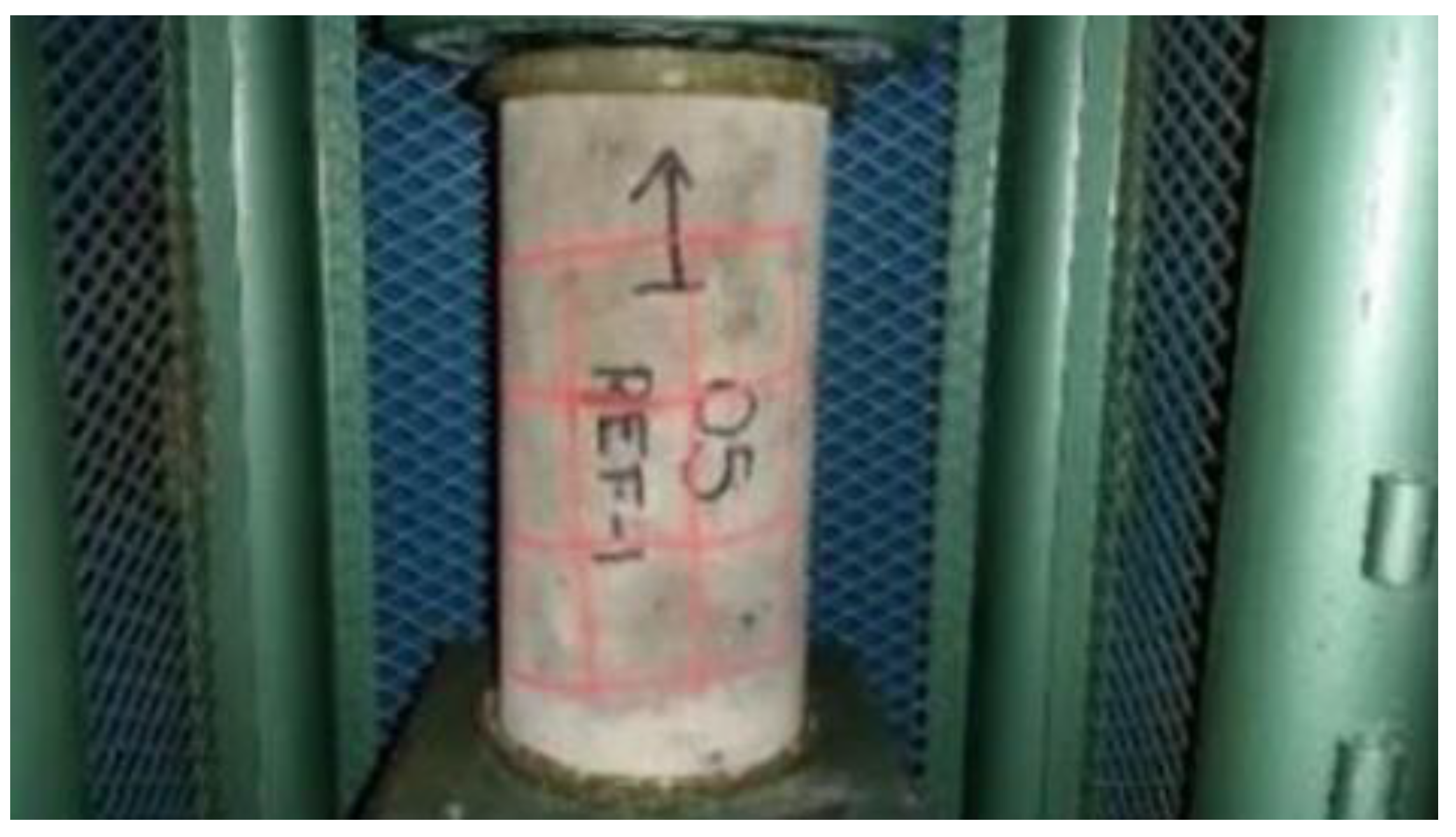

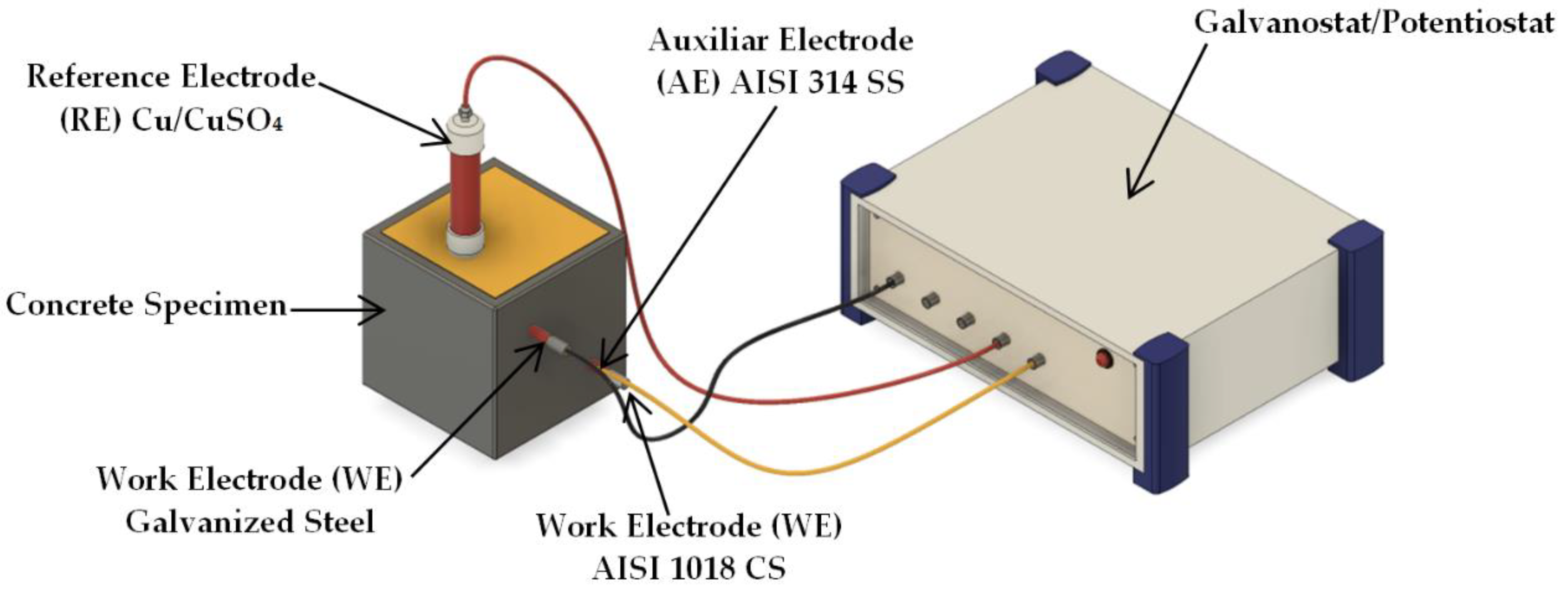
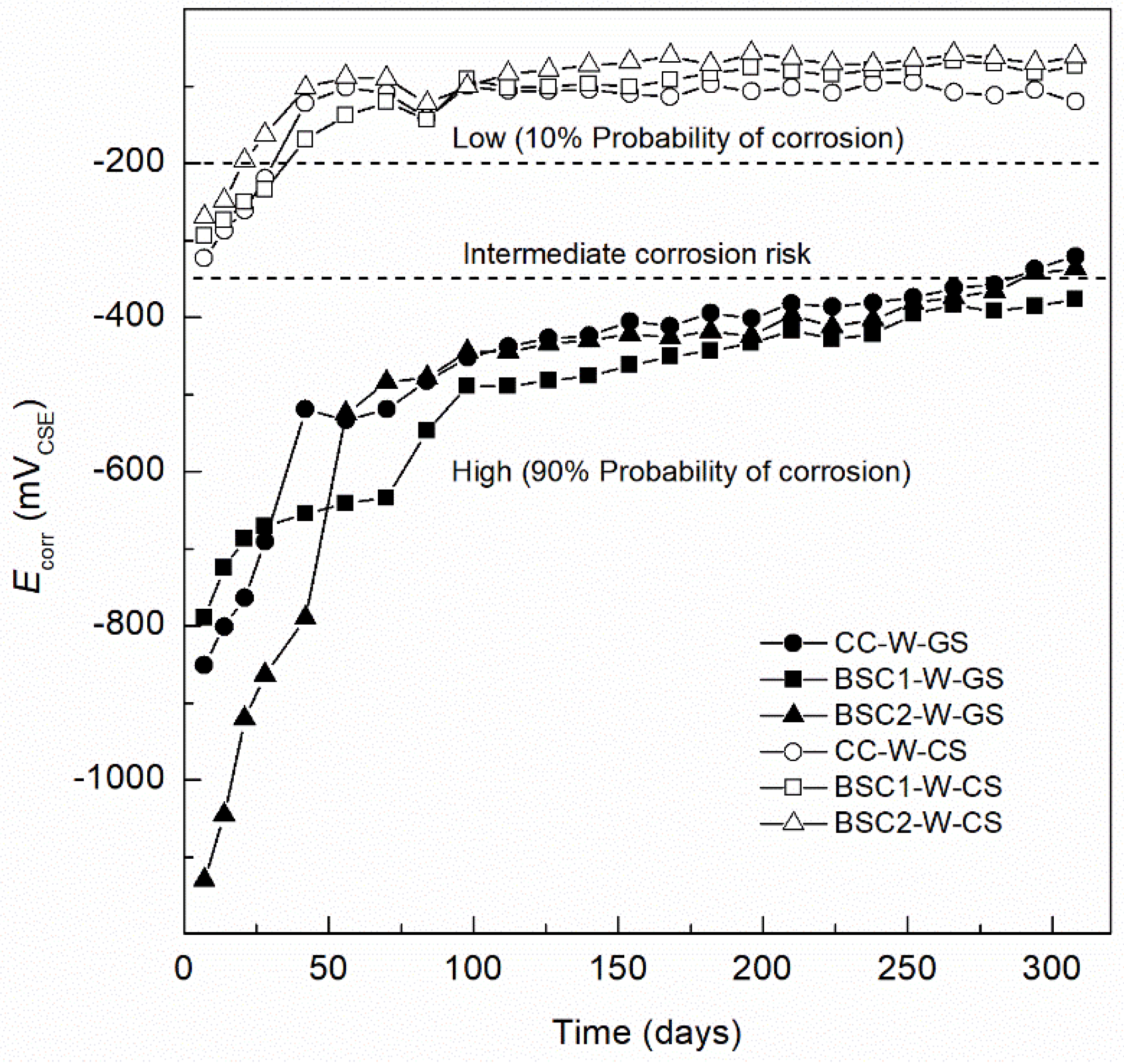
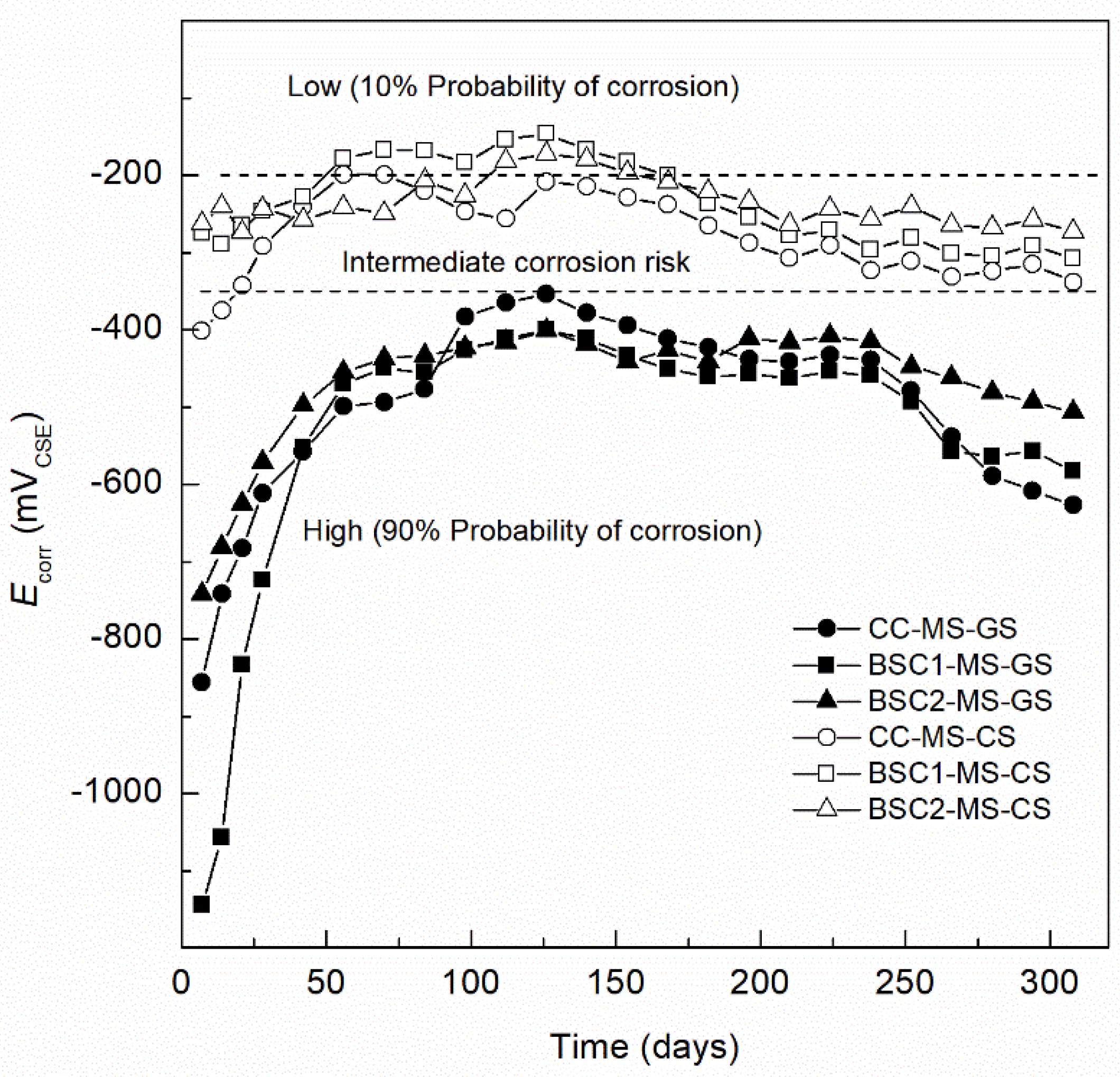

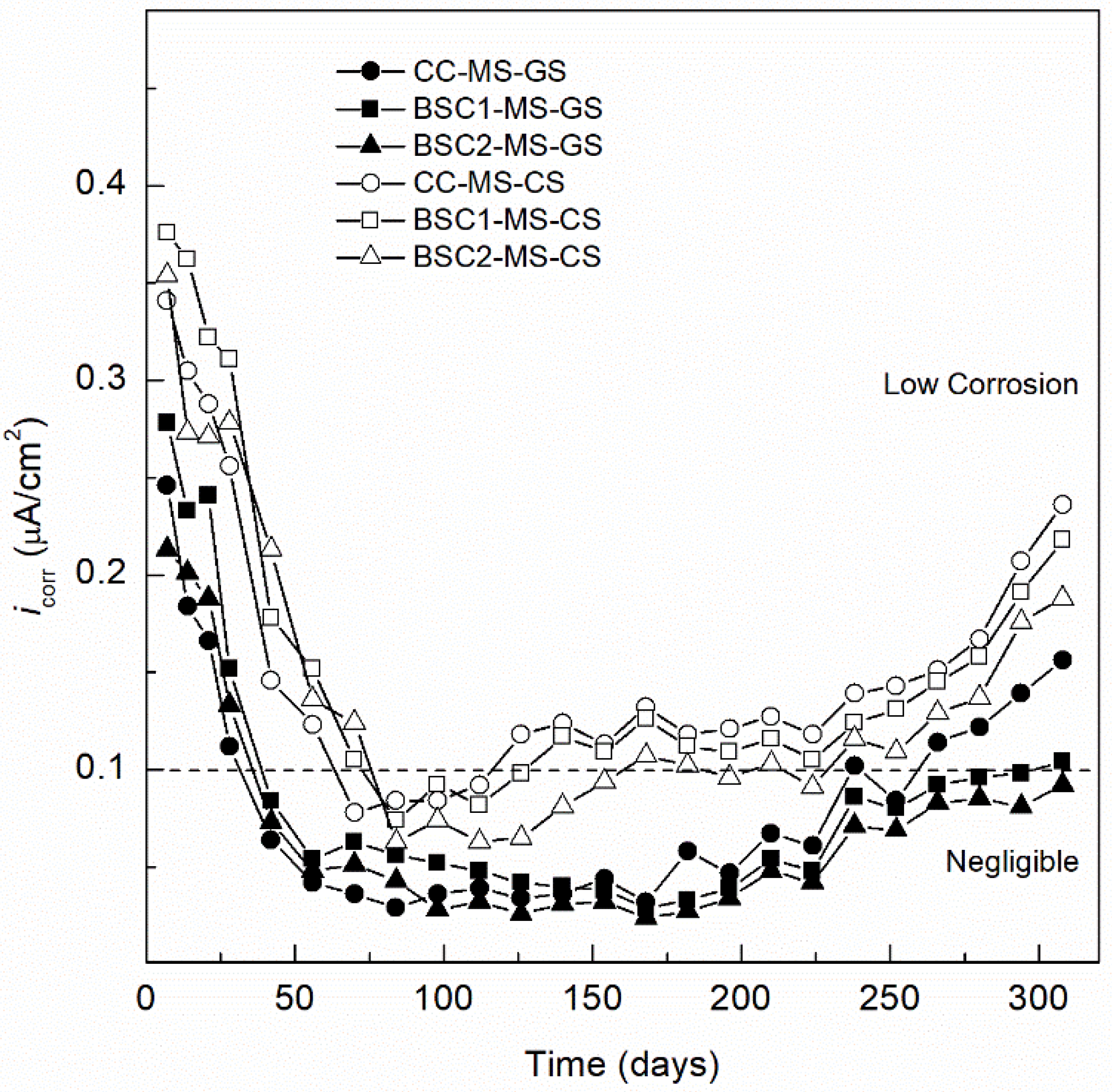
| Physical Properties of Materials | Aggregate | |
|---|---|---|
| Coarse | Fine | |
| Maximum Aggregate Size (mm) | 19.05 | - |
| Bulk Density (Unit Weight) (kg/m3) | 1372 | - |
| Relative Density (Specific Gravity) | 2.4 | 2.6 |
| Absorption (%) | 3.1 | 1.6 |
| Fineness Modulus | - | 2.8 |
| Materials | CC (100% CPC 30R) | BSC-1 (90% CPC 30R-10% SCBA) | BSC-2 (90% CPC 30R-10%SF) |
|---|---|---|---|
| Water | 205 | 205 | 205 |
| Cement | 315 | 283.5 | 283.5 |
| SCBA | 0 | 31.5 | 0 |
| SF | 0 | 0 | 31.5 |
| Coarse aggregate | 928 | 928 | 928 |
| Fine aggregate | 762 | 762 | 762 |
| Material | Concentration (wt.%) | |||||||||
|---|---|---|---|---|---|---|---|---|---|---|
| SO3 | MgO | SiO2 | Fe2O3 | Al2O3 | CaO | K2O | Na2O | Others | LOI | |
| SCBA | 0.4 | −4.3 | 77.14 | 3.87 | 5.17 | 3.9 | 0.83 | 0.2 | 1.39 | 2.8 |
| SF | 0.33 | 0.40 | 92.26 | 1.57 | 0.79 | 0.43 | 1.31 | 0.38 | − | − |
| Test | CC (100% CPC 30R) | BSC1 (90% CPC 30R-10% SCBA) | BSC2 (90% CPC 30R-10% SF) |
|---|---|---|---|
| Slump, mm | 20 | 15 | 10 |
| Temperature, °C | 23.0 | 22.0 | 21.0 |
| Density, kg/m3 | 1896 | 1892 | 1916 |
| Compressive strength, MPa | 21.18 | 20.69 | 25.20 |
| Test Environments | ||||
|---|---|---|---|---|
| Conventional Concrete / Binary Sustainable Concretes | DI-Water | MgSO4 | ||
| CS | GS | CS | GS | |
| CC (100% CPC 30R) | CC-W-CS | CC-W-GS | CC-MS- CS | CC-MS-GS |
| BSC1 (90% CPC 30R-10% SCBA) | BSC1-W-CS | BSC1-W-GS | BSC1-MS- CS | BSC1-MS-GS |
| BSC2 (90% CPC 30R-10% SF) | BSC2 -W-CS | BSC2-W-GS | BSC2-MS- CS | BSC2-MS-GS |
- CC = Conventional concrete
- BSC1 = Binary sustainable concrete 1
- BSC2 = Binary sustainable concrete 2
- W = deionized water (DI-water) (control medium)
- MS = 3.5 wt.% MgSO4 solution (aggressive medium)
- CS = AISI 1018 carbon steel
- GS = Galvanized steel
| Material | Element, wt.% | |||||||||
|---|---|---|---|---|---|---|---|---|---|---|
| C | Si | Mn | P | S | Cr | Ni | Mo | Cu | Fe | |
| AISI 1018 | 0.20 | 0.22 | 0.72 | 0.02 | 0.02 | 0.13 | 0.06 | 0.02 | 0.18 | Balance |
| Al | Bi | Cd | Cu | Fe | Ni | Pb | Zn |
|---|---|---|---|---|---|---|---|
| 0.003 | 0.007 | 0.0002 | 0.01 | 0.03 | 0.06 | 0.48 | Balance |
| Ecorr (mV vs. CSE) | Corrosion Condition |
|---|---|
| Ecorr > −200 | Low (10% of risk corrosion) |
| −200 > Ecorr > −350 | Intermediate corrosion risk |
| −350 > Ecorr > −500 | High (<90% of risk corrosion) |
| Ecorr < −500 | Severe Corrosion |
| icorr (µA/cm2) | Corrosion Level |
|---|---|
| icorr ≤ 0.1 | Negligible (Passivity) |
| 0.1 < icorr < 0.5 | Low Corrosion |
| 0.5 < icorr < 1 | Moderate Corrosion |
| icorr > 1 | High Corrosion |
Publisher’s Note: MDPI stays neutral with regard to jurisdictional claims in published maps and institutional affiliations. |
© 2021 by the authors. Licensee MDPI, Basel, Switzerland. This article is an open access article distributed under the terms and conditions of the Creative Commons Attribution (CC BY) license (http://creativecommons.org/licenses/by/4.0/).
Share and Cite
Landa-Ruiz, L.; Baltazar-Zamora, M.A.; Bosch, J.; Ress, J.; Santiago-Hurtado, G.; Moreno-Landeros, V.M.; Márquez-Montero, S.; Méndez, C.T.; Borunda, A.; Juárez-Alvarado, C.A.; et al. Electrochemical Corrosion of Galvanized Steel in Binary Sustainable Concrete Made with Sugar Cane Bagasse Ash (SCBA) and Silica Fume (SF) Exposed to Sulfates. Appl. Sci. 2021, 11, 2133. https://doi.org/10.3390/app11052133
Landa-Ruiz L, Baltazar-Zamora MA, Bosch J, Ress J, Santiago-Hurtado G, Moreno-Landeros VM, Márquez-Montero S, Méndez CT, Borunda A, Juárez-Alvarado CA, et al. Electrochemical Corrosion of Galvanized Steel in Binary Sustainable Concrete Made with Sugar Cane Bagasse Ash (SCBA) and Silica Fume (SF) Exposed to Sulfates. Applied Sciences. 2021; 11(5):2133. https://doi.org/10.3390/app11052133
Chicago/Turabian StyleLanda-Ruiz, Laura, Miguel Angel Baltazar-Zamora, Juan Bosch, Jacob Ress, Griselda Santiago-Hurtado, Victor Manuel Moreno-Landeros, Sabino Márquez-Montero, Ce Tochtli Méndez, Adan Borunda, César A. Juárez-Alvarado, and et al. 2021. "Electrochemical Corrosion of Galvanized Steel in Binary Sustainable Concrete Made with Sugar Cane Bagasse Ash (SCBA) and Silica Fume (SF) Exposed to Sulfates" Applied Sciences 11, no. 5: 2133. https://doi.org/10.3390/app11052133
APA StyleLanda-Ruiz, L., Baltazar-Zamora, M. A., Bosch, J., Ress, J., Santiago-Hurtado, G., Moreno-Landeros, V. M., Márquez-Montero, S., Méndez, C. T., Borunda, A., Juárez-Alvarado, C. A., Mendoza-Rangel, J. M., & Bastidas, D. M. (2021). Electrochemical Corrosion of Galvanized Steel in Binary Sustainable Concrete Made with Sugar Cane Bagasse Ash (SCBA) and Silica Fume (SF) Exposed to Sulfates. Applied Sciences, 11(5), 2133. https://doi.org/10.3390/app11052133







